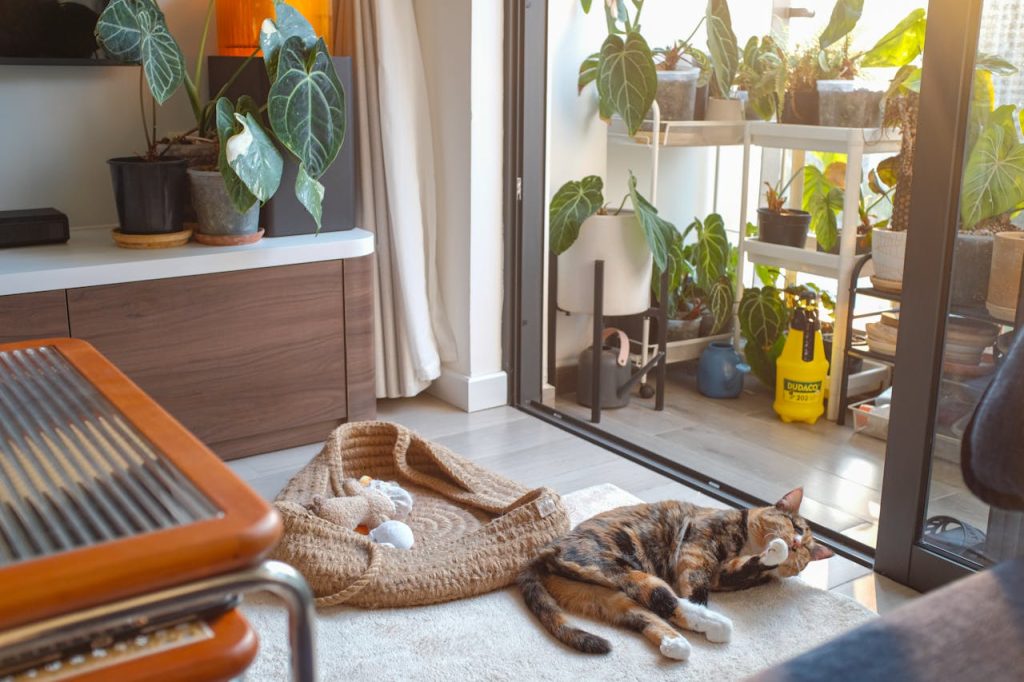
15 Great Tips to Cat Proof Apartment Spaces the Right Way
Cats are curious, agile, and occasionally chaotic—which makes apartment living an adventure when they’re involved. Whether you're adopting your first kitten or moving with a seasoned feline, it's essential to cat proof apartment spaces from floor to ceiling. From preventing chewed cords to protecting your plants and furniture, these tips will help you create a safe, comfortable home for both of you.
1. Secure Cords and Chargers
Cats love to nibble, paw, or pounce on loose cords—which can lead to frayed wires and electric shocks. Use cord concealers, split tubing, or adhesive cord organizers to keep wires tucked away and off the ground.
For extra protection, spray cables with a pet-safe bitter deterrent or use chew-resistant cable wraps. A few simple tweaks can save both your tech and your cat from harm.
2. Keep Toxic Plants Out of Reach
Not all greenery is feline-friendly. Some popular houseplants like lilies, pothos, and snake plants are toxic to cats. Instead, opt for pet-safe plants like spider plants, parlor palms, or Boston ferns.
Place any questionable plants on high shelves or behind barriers—or skip them altogether to avoid the risk of ingestion.
3. Install Latches on Cabinets and Drawers
Cats are clever and persistent. If they hear the crinkle of treats or smell something tasty, they might try opening your cabinets. Prevent this with magnetic locks or stick-on childproof latches.
This is especially important in kitchens and bathrooms where cleaners, medications, or sharp tools might be stored. Simple, renter-friendly latches can save you from dangerous surprises.
4. Protect Windows with Screens or Stoppers
Open windows are a hazard for curious cats—especially in high-rise apartments. Always install tight-fitting screens or adjustable window stoppers to prevent your cat from slipping through an opening.
Even small gaps can be dangerous, so regularly check for loosened mesh or broken frames. If your windows swing outward, consider safety grilles or heavy-duty mesh panels instead.
5. Use Double-Sided Tape on Off-Limit Surfaces
Cats dislike sticky textures, making double-sided tape a great tool to deter them from climbing where they shouldn’t—like counters, dressers, or bookshelves.
Apply strips to edges of surfaces temporarily. After a week or two, most cats lose interest. For long-term prevention, try cat-safe deterrent mats or strategically placed scratching posts nearby.
6. Anchor Wobbly Furniture and Tall Items
Cats love to climb—and if your apartment features tall shelves, unstable floor lamps, or leaning mirrors, they can become tipping hazards. Use anti-tip furniture straps or wall anchors to secure them.
Even lightweight items like coat racks or plant stands can fall if your cat jumps or rubs against them. Think of your space like baby-proofing, but with vertical ambitions.
7. Cover Trash Cans and Food Bins
Cats are natural scavengers—and your trash can smells like a treasure chest to them. Invest in a lidded garbage bin (ideally with a foot pedal or locking top) to keep curious paws out.
This applies to dry food bins too. Choose airtight containers with locking lids, especially if you store them low to the ground. Bonus: it keeps food fresher and bugs out.
8. Block Off Tight Hiding Spots
Cats love small, dark spaces—but getting stuck behind appliances or wedged under furniture isn’t safe. Use foam gap blockers or cut-to-fit cardboard panels to block gaps behind your stove, washer, or fridge.
Also check under beds, sofas, and dresser bases. Add bins, baskets, or storage boxes underneath to keep the space functional and feline-free.
9. Choose Scratch-Friendly Furniture Alternatives
Instead of fighting your cat’s natural urge to scratch, give them acceptable surfaces. Invest in sturdy vertical or horizontal scratchers and place them near favorite nap spots or problem areas.
If your cat keeps targeting the couch, try placing a scratch mat or post directly beside it. Cover vulnerable furniture with protective pads or slipcovers while redirecting their behavior.
10. Store Cleaning Supplies Safely
Many common cleaners—like bleach, ammonia, or scented sprays—can be toxic to cats if inhaled or ingested. Always store them in a secured cabinet, well out of reach.
For bonus safety, switch to pet-safe cleaning products. And never leave buckets, mops, or damp rags out unattended, as curious cats might lick or roll in them.
11. Be Cautious With Candles and Open Flames
Cats have a habit of jumping onto tables and counters—exactly where candles, incense, or stovetop flames often sit. This creates a serious burn or fire risk.
Stick with flameless LED candles or wall plug-ins for ambiance. If you must light a candle, never leave the room while it’s burning and keep it far from reach.
12. Close Toilet Lids and Washer Doors
Believe it or not, cats can and do fall into open toilets or explore inside washers and dryers. Always keep toilet lids closed and laundry machine doors shut when not in use.
Make it part of your daily habit, especially before running a load of laundry. A quick visual check can prevent a tragic accident.
13. Hide Breakables and Trinkets
That cute vase on your windowsill or your favorite ceramic mug on the counter? It's fair game to a curious cat. Anything lightweight or wobbly could become a casualty of the midnight zoomies.
Store fragile items behind closed cabinet doors or on secure, non-climbable shelves. Use museum putty to anchor small décor pieces you want to display safely.
14. Create a Climbing Zone to Redirect Energy
You can’t train a cat not to climb—but you can give them a better alternative. A cat tree, wall shelves, or window perch provides stimulation and a view, while saving your furniture.
Redirecting your cat’s natural instincts with a dedicated vertical zone can dramatically reduce unwanted jumping or scratching elsewhere.
15. Rotate Toys and Add Enrichment
A bored cat is a destructive cat. Keep your space peaceful by rotating toys weekly and introducing new enrichment options. Puzzle feeders, DIY hide-and-seek boxes, and feather wands are great starters.
For even more ideas, check out our guide on indoor cat enrichment. A mentally satisfied cat is less likely to chew, climb, or knock things off shelves.
Final Thoughts: Cat-Proofing With Love
Cat-proofing your apartment isn’t just about protecting your stuff—it’s about making your home safer, calmer, and more enjoyable for both you and your cat. A little prevention now can save a lot of stress (and broken glass) later.
With the right setup, your apartment can be a feline paradise—full of adventure, comfort, and peace of mind. You've got this, busy pet parent!
Frequently Asked Questions
How do I cat proof apartment windows?
Install secure screens or adjustable window stoppers to prevent your cat from falling or escaping. Double-check frames regularly for gaps, and avoid leaving windows open without supervision—especially in high-rise buildings.
What furniture is best for apartments with cats?
Look for furniture with sturdy frames, claw-resistant upholstery, and smooth, wipeable surfaces. Modular shelving or cat trees with built-in scratchers are great multi-purpose solutions for tight spaces.
Are there any smells that keep cats off furniture?
Yes—many cats dislike citrus scents. You can use citrus-scented sprays or essential oil diffusers (pet-safe only) to deter them from certain areas. Just make sure the products are non-toxic and diluted.
How can I stop my cat from chewing cords?
Use cord protectors, conceal wiring behind furniture, or apply a pet-safe bitter spray to make cords unappealing. Providing chew-friendly toys can also redirect the behavior in a healthier way.
Do I really need to block off under furniture?
Yes—especially in small apartments where tight spaces behind appliances or under beds can trap your cat or collect dangerous dust and debris. Simple foam blockers or storage bins can solve the problem fast.

Join the Busy Pet Parent Newsletter!
Get easy routines, time-saving tips, and the latest gear reviews—delivered straight to your inbox.
Perfect for busy pet owners, apartment dwellers, and anyone who wants a happy, healthy companion (without the stress).
Exclusive guides & checklists
Product recommendations & deals
No spam—unsubscribe anytime!




